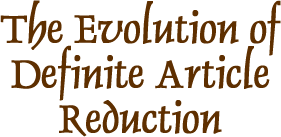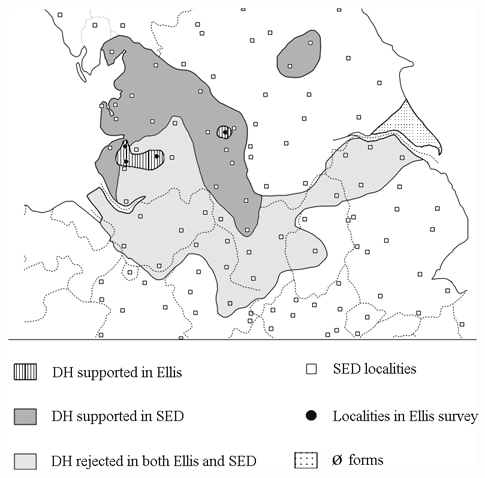


 |
 |
 |
| "The origin of [Definite Article Reduction] is assumed to be the assimilation of the initial fricative of the Middle English definite article 'þe' to produce a 'te' form, a sound change recorded for many dialects of Middle English." (Jones 2002: 325) |
The material in this page, which is presented in an extremely condensed form is drawn entirely from Jones (2002). Herein, consideration is given solely to the evolution of definite article reduction (DAR). The development of the definite article in Standard British English is discussed in the Overview section. All references to "localities" within the text relate to survey points within northern England and not solely to those within the boundaries of Yorkshire.
In relation to the opening quote, Jones both examines the notion of assimilation and tests the theory using material from Ellis (1889) and the Survey of English Dialects (SED). It should be noted that all citations and examples given below are attributable to Jones.
| progressive assimilation: refers to the
modification of a speech sound so that it becomes more like the sound
preceding it. Thus, in this case, the dental fricative [ |
| fricative: sound produced by
bringing two articulators (e.g. tongue and upper teeth) together
but not close enough to stop the airflow (thus creating friction), e.g.
th as in thin which is denoted phonetically
as [ |
| elision: the omission of a sound or sounds
in speech. For example library [ |
Assimilation theory
According to Jones, a general consensus exists that all the various
forms of DAR have their origins in progressive
assimilation of the fricative
of Middle English (ME) þe. The resulting form te
is well attested in a number of ME texts. The accepted thinking is that this
assimilated form marks the primary phase in the development of the reduced article.
However, it should be noted that the processes of assimilation occurred in a large number of ME dialects and not just in those currently featuring DAR. Moreover, words other than the definite article were also affected e.g.
| þe |
they | þ |
thou |
| þeggre | their | þær | there |
| þiss | this | þærfore | therefore |
| þohh | though | þanne | then |
|
After Jones (2002: 330) |
The vowel-less forms of the reduced article identified in the SED (e.g. [![]() ],
[
],
[![]() ],
[
],
[![]() ]
etc) are believed to be the result of elision.
However, Viereck (1995: 299) opines that such elision may only have happened
following the modified consonantal realization mentioned above. Jones supports
this notion by pointing out that there is no textual evidence of non-fricative
vowel-less forms (i.e. generally written as t' in dialect literature) prior
to George Meriton's A Yorkshire Dialogue in 1673. He also notes that
the elision of the vowel in fricative forms prior to this date are seen to occur
only when closely located to vowels.
]
etc) are believed to be the result of elision.
However, Viereck (1995: 299) opines that such elision may only have happened
following the modified consonantal realization mentioned above. Jones supports
this notion by pointing out that there is no textual evidence of non-fricative
vowel-less forms (i.e. generally written as t' in dialect literature) prior
to George Meriton's A Yorkshire Dialogue in 1673. He also notes that
the elision of the vowel in fricative forms prior to this date are seen to occur
only when closely located to vowels.
The Conditioning environment
Examination of different ME texts (e.g. The Bestiary, The Ormulum)
reveals that te appears to a large extent after /t/ and /d/ (e.g. þatt
te "that the" and mid te "with the" - see Vierick,
1995). Other occurrences of te have also been found following /s/ (Reaney,
1927) though Jones expresses uncertainty as to whether this is a "geographical
or diachronic variation". However, the idea that such phonological environments
are related to the evolution of DAR runs up against a number of problems, mainly
that:
Jones (2000) reasons that if the assimilation theory described above is indeed the source of DAR, then present-day variations should not take the fricative form when immediately preceded by /t/, /d/ or /s/ (and, he suggests, word-final /z/). To test this theory (henceforth known as the development hypothesis) he examines data from Ellis (1889) and the SED.
The Data
The Ellis data
This data is derived from two source texts which have been transcribed into
dialect, namely: the comparative specimen and the dialect test.
Jones examines each of these datasets separately on the grounds that, as a general
rule, only one text per locality was employed for the purposes of data collection.
In addition, as observed by Jones, the "phonological environments including
the definite article are not comparable between the two". His findings
are as follows:
The comparative specimen
Of the 64 localities included in the database only 24 reveal examples of DAR
in both fricative and non-fricative forms. Analysis of this sample reveals that:
Thus the majority of these environments display a fricative form of the reduced
article (e.g. at th' corner, that th' youngest) and accordingly
the development hypothesis is not supported.
The dialect test
Although the data includes in excess of 300 occurrences of DAR, the source text
contains only a single phrase (i.e. won't the old) incorporating the
phonological environment responsible for the activation of the assimilatory
processes recognized in Middle English texts. Jones identifies only six locations
displaying allomorphs possibly relating to the development of DAR. He includes
a further six localities on the basis of (t') assimilating to (s) or (s'). Within
these samples the data from only a single locality provides support for the
development hypothesis.
The SED data
In relation to the occurrence of DAR, Jones examines all the data in the
Basic Material including that from the incidental material. He also analyses
the actual recordings. Forms of "the one" and "the other"
are universally disregarded as being of possibly different historical origins
(see, for example, the suggested origins of tother).
The findings are as follows:
Basic material
Jones identifies 2,621 examples of DAR over 101 localities. However, after the
exclusion of cases displaying linguistic environmental ambiguity and localities
deemed to show insufficient or irrelevant data, only 39 locations exhibiting
variability between fricative and non-fricative forms remain for analysis. In
contrast to the findings from the Ellis material, the data from 22 of these
survey points support the development hypothesis.
Recordings
Within this dataset 2,228 instances of DAR are identified although some survey
points are ignored because of the small numbers of reduced articles in evidence.
However, only 17 localities demonstrated variability between fricatives and
non-fricatives and only 9 of these support the development hypothesis.
The Overall Position
Taking into account the findings from both sets of data, support for the development
hypothesis appears to be relatively sparse. The overall position is summarised
in the following map.
 |
After Jones 2002: 342 |
Conclusion
Jones holds the view that a further more detailed wide-ranging survey is required
before an alternative model of DAR development can be formulated. However, he
does offer some speculation on the origins of the zero form in the Holderness
region of the East Riding of Yorkshire. He also puts forward his own theory
regarding the development of DAR.
In relation to the zero forms of the Holderness area, Jones calls into question
the proposal that this development links back to the time of Norse settlement.
Discounting the claim that Old Danish gave rise to the zero form whilst plosive
forms have their roots in Old Norwegian. Jones observes that, whilst [![]() ]
> [
]
> [![]() ] might be considered
to be a natural phonological progression, the East Riding displays "no
linguistic separation from the adjoining dialect area in other major respects
(see Wakelin. 1977: 102-3)" He therefore takes the view that it would be
an extraordinary occurrence if the definite article alone was influenced by
the effects of linguistic contact.
] might be considered
to be a natural phonological progression, the East Riding displays "no
linguistic separation from the adjoining dialect area in other major respects
(see Wakelin. 1977: 102-3)" He therefore takes the view that it would be
an extraordinary occurrence if the definite article alone was influenced by
the effects of linguistic contact.
Concerning DAR as a whole, Jones states that there is no evidence to support
the notion that the origin lies in the final <t> of the Old English demonstrative
þat. He observes that, judging from the orthographic convention employed in A
Yorkshire Dialogue (Cawley, 1959), the present-day forms of allomorphic
variation appear to have evolved by the late 17th century. Furthermore, all
such variations consist fundamentally of three sounds, [t], [![]() ]
and [
]
and [![]() ] in different combinations
(see Variations). Because of known
crosslinguistic mutations (i.e. /
] in different combinations
(see Variations). Because of known
crosslinguistic mutations (i.e. /![]() /
> /t/ and /t/ > /
/
> /t/ and /t/ > /![]() /)
Jones suggests that it is these three basic sounds which are the source of DAR.
/)
Jones suggests that it is these three basic sounds which are the source of DAR.
Sources
Cawley, A.C. (ed) (1959) George Meriton's 'A Yorkshire Dialogue'. 1683.
Yorkshire Dialect Society, reprint 2.
Ellis, A. J. (1889) On Early English Pronunciation, Part V. The existing phonology of English dialects compared with that of West Saxon speech. London: Trübner and Co.
Jones, M. J. (2002) The origin of Definite Article Reduction in northern English dialects: evidence from dialect allomorphy. English Language and Linguistics 6.2: 325-345.
Reaney, P. H. (1927) A grammar of the dialect of Penrith (Cumberland) Publications of the University of Manchester, English series 15.
Viereck, W. (1995) Realizations of the definite article in dialectal English and how and when they originated. In Fisiak, J. (ed) Medieval dialectology, The Hague: Mouton de Gruyter. 295-307.
Wakelin, M. F. (1977) English Dialects: an introduction, London: Athlone Press.